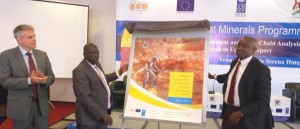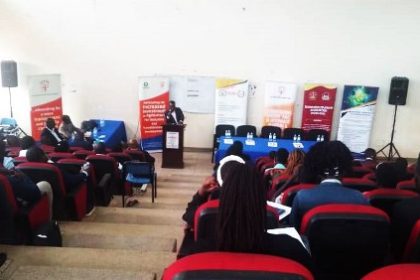EU joins UNDP to produce Uganda’s first mineral report

Merel (left) applauds the unveiling of Uganda’s first Baseline mineral assessment report with Thomas Ole-Kuyan of the UNDP and Baguma from the energy and minerals ministry.
March 20, 2018—The Ministry of Energy and Minerals Development (MEMD) in partnership with the European Union (EU) and the United Nations Development Programme (UNDP) has launched Uganda’s first Baseline Assessment and Value Chain Analysis Reports for the Development Minerals Sector.
“The EU in Uganda is committed to supporting and strengthening not only human development, but also good governance and accountability in the mining sector and beyond. Uganda is endowed with rich natural resources which, if harnessed in the right manner, can continue to spur economic and social advancement,” Cedric Merel, the Head of Cooperation, at the EU Delegation to Uganda said.
According to Jennifer Hinton of Levin Sources who were contracted to do the study, the main aim of the report was to provide a foundation for evidence based policy and decision making in Uganda by profiling the economic significance, scope and potential of the sector as well as fostering an understanding of the sector’s technical, legal, social, occupational and environmental challenges and opportunities.
The report focus mainly on artisanal and small scale (ASM) operators and related micro and small enterprises with data collected from over 42 sites in 22 districts across Uganda.
Merel said the report will be a very vital resource that will inform collective efforts in transforming the mining sector in Uganda.
Thomas ole-Kuyan, the Assistant UNDP Country Director said Development Minerals are economically important to local communities and the country at large hence the need to put more focus on the sector by formalizing it.
“As you will hear today, Development Minerals are a very critical driver for development in Uganda due to their contribution of approximately 390,000 jobs, 7% of GDP and grossing over $350 million in value as per 2016 estimates” Kuyan said.
Mined close to communities, Development Minerals have strong domestic economic linkages. Examples include industrial minerals, construction materials such as sand and cement together with dimension stones.
According to officials at the launch, the latent potential of Development Minerals is huge. The construction sector’s 6% growth annually alone contributes over 12% of Uganda’s Gross Domestic Product (GDP) and conservative estimates indicate that more than one million people in the country are engaged in this sector, with women making up more than 44% of the workforce.
Zachary Baguma the Director, Directorate of Geological Survey and Minerals at MEMD, who officiated at the function said the report had come at the right time when the government is formulating a policy to guide artisan mining in Uganda. He said the recommendations made in the report will be put under consideration.
“We have been doing trainings for small miners on how they can improve their small minerals to benefit more from them and we have seen a very big response to this call. Some 70 to 90 year olds are seeking knowledge on how to improve their mineral products as they have been cheated by middle men,” Baguma said.
Development Minerals are those minerals that are used in daily lives to make products such as plates, paint and toothpaste, to build houses and pave roads. Uganda boasts of a diversity of development minerals including construction minerals such as limestone, clay gypsum, marble and sand among others. It’s also home to various industrial minerals and semi-precious stones. Despite mapping of these natural resources, many of them remain largely unexploited.
The Baseline Assessment and Value Chain Analysis Reports of the Development Minerals Sector are therefore intended to shed a light on these minerals, sharing comprehensive data on the range of these natural resources, their sites of extraction and the number of people who benefit from them especially in terms of employment. In addition the reports contain analyses of the current laws and implications for the Development Minerals sector and provide recommendations on how the sector can be transformed to drive inclusive growth in Uganda.

 Shell Club rewards first winners with brand new motorbikes in Mbale
Shell Club rewards first winners with brand new motorbikes in Mbale
 CSBAG roots for increased funding for renewable energy
CSBAG roots for increased funding for renewable energy
 Equity walks tried and tested path to deliver solid half-year
Equity walks tried and tested path to deliver solid half-year
 Nile Breweries primes retailers for brave new world
Nile Breweries primes retailers for brave new world
 Uganda calls for collaboration with airlines in fight against illicit trade in wildlife
Uganda calls for collaboration with airlines in fight against illicit trade in wildlife
 Airline industry top guns dust-off passports for Uganda hosted 55th AFRAA annual meet
Airline industry top guns dust-off passports for Uganda hosted 55th AFRAA annual meet
